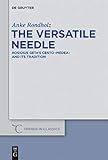The Versatile Needle : Hosidius Geta’s Cento "Medea" and Its Tradition / Anke Rondholz.
Material type: TextSeries: Trends in Classics - Supplementary Volumes ; 15Publisher: Berlin ; Boston : De Gruyter, [2012]Copyright date: ©2012Description: 1 online resource (172 p.)Content type:
TextSeries: Trends in Classics - Supplementary Volumes ; 15Publisher: Berlin ; Boston : De Gruyter, [2012]Copyright date: ©2012Description: 1 online resource (172 p.)Content type: - 9783110283815
- 9783110283860
- 871/.01 23
- PA6445.H35 A737 2012eb
- online - DeGruyter
- Issued also in print.
| Item type | Current library | Call number | URL | Status | Notes | Barcode | |
|---|---|---|---|---|---|---|---|
 eBook
eBook
|
Biblioteca "Angelicum" Pont. Univ. S.Tommaso d'Aquino Nuvola online | online - DeGruyter (Browse shelf(Opens below)) | Online access | Not for loan (Accesso limitato) | Accesso per gli utenti autorizzati / Access for authorized users | (dgr)9783110283860 |
Frontmatter -- Contents -- Prolegomena -- Chapter 1. Origin and Development of the Cento -- Chapter 2. What is a Cento? -- Chapter 3. Hosidius Geta, Medea: an Introduction -- Chapter 4. Hosidius Geta’s Medea: Form and Technique -- Chapter 5. The Relationship Between Cento and Primary Text -- Chapter 6. Hosidius Geta’s Place in the Medea Tradition -- Bibliography -- General Index -- Index of Vergilian Lines Used in the Cento
restricted access online access with authorization star
http://purl.org/coar/access_right/c_16ec
The cento-tragedy Medea usually attributed to Hosidius Geta was transmitted in the Codex Salmasianus (now Codex Parisinus 10318). This is a comprehensive study and reevaluation of the text against the background of the ancient cento tradition, also providing a new English translation. After developing a new definition of the ancient conception of the cento in general, Geta’s cento technique and his use of the Vergilian text as well as his relation to the Greek and Roman models for his Medea are examined. It is shown that his play is innovative and sophisticated in both technique and content.
Issued also in print.
Mode of access: Internet via World Wide Web.
In English.
Description based on online resource; title from PDF title page (publisher's Web site, viewed 28. Feb 2023)


